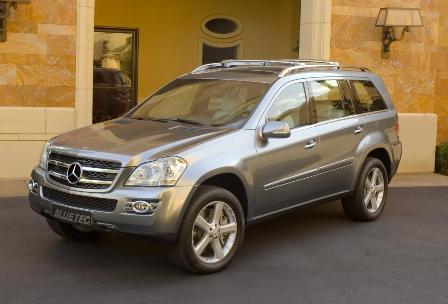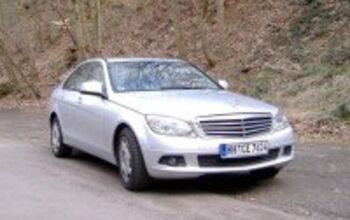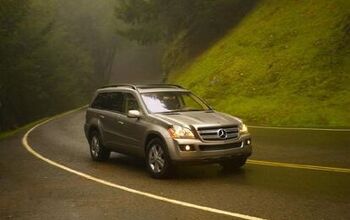2008 Mercedes-Benz GL 320 CDI Review
I flew into Los Angeles with aspirations of driving something powerful; I had visions of some mighty motor displacing six liters or more. Anything with the letters AMG on the back would have suited me just fine. Instead I was staring at a gigantic Mercedes GL 320 CDI. That's CDI as in "diesel." I reckoned it was going to be a long drive to San Diego. I reckoned wrong.
Walking around the Mercedes GL class, I struggled to find inspiration. The SUV's descending belt line and downwards sloping swage lines create a forward facing arrow-like shape– which does an excellent job of hiding the GL's massive bulk. It's a Midwest corn silo SUV; the closer you get, the more amazed you are at its size. But the overall effect is squared off and blunt, even workmanlike. The GL's snout– complete with bootylicious big Benz badge– rescues the beast from invisibility on both the brand and design level.
I climbed up the side of the beast, planted myself behind the wheel and began looking for the CB radio, finding only the usual Mercedes COMAND stack. The view from the driver's throne is certainly commanding– as long as your viewing angle doesn't dip lower than 30 degrees below the horizon. Beneath that, all things are invisible– small children, motorcycles, Toyotas.
The GL320's materials quality isn't up to Range Rover's "tough luxury," but the assembly is outstanding. The ‘Bama-built Benz looks and feels built to last (as in longevity, not relative traffic position). Less enjoyably, the not-so-cheap tester's range of adjustments and toys were quite limited, and the sound system's quality and functionality had me searching for my IPod. On the positive side, the GL's interior space utilization and practicality– multiple seat flips, cupholders, cubbies, etc.– is ideal for a large family with a gaggle of messy tikes.
Including the conjunction, the big Benz' driving experience can be summed up in three words: imperious and impervious. Straight line driving is dreamy and plush, with no vibrations to speak of. Other than that… the GL 320's limited visibility rules-out quick and aggressive lane changes; every move requires careful planning. Fortunately, I was only required to turn twice in 100 miles, so I didn't have much opportunity to experience the pleasures of helming the leaning tower of Benz.
The GL 320 CDI's steering was a tad vague at the straight ahead and the brakes oddly squishy, but the dynamics were wholly appropriate with the rest of the driving experience. I wasn't bothered about testing the stoppers' performance in a panic stop; I felt I could pretty much run over or through anything that crossed my path without noticing (save in a legal and moral sense). Cruising along serenely, captain of a dreadnought class vehicle, I instantly understood why these giant SUV populate the American interstates.
And if perchance I ventured to Big Bear, I felt confident the GL 320 could handle anything nature threw my way. Like most Mercedes owners/drivers, I've seen the commercials. What more do you want? One button off-road handling and traction gizmo recalibration? Done. Seventy-five hundred pounds of towing capacity? Riva owners of the world rejoice!
The GL 320 CDI's diesel engine's performance is extremely well suited to the vehicle's mellow mission. Although the GL CDI's 3.0-liter turbocharged V6 powerplant produces "only" 215hp, the oil-burning SUV drives like a tsunami. It accumulates speed relentlessly, surfing on a never-ending wave of torque (398 lb-ft @ 1,600 – 2,800 rpm). The truck had enough power to indulge every passing whim with calm assurance, while tree stumps quivered in fear.
Given the GL's 5313 pound curb weight and the aforementioned braking pillow-cum-pedal, I had to temper my accelerative enthusiasm, lest I evoke runaway train metaphors. Pricing for this leviathan starts in the mid $50k's, but quickly makes its way into the $70k's.
And speaking of money– or at least political correctness– anyone who purchases a giant SUV must, at some point, face the mileage issue. The BlueTec diesel powering the GL 320 CDI offers a great salve to the well-heeled, environmentally-conscience SUV driver. I managed 23 mpg at a steady state 80mph. In EPA terms, the GL320 CDI represents a 30 percent improvement over its gas-equivalent.
At last, the best of the German-engineered modern diesel engines are making their way to the US of A, erasing all memories of the Detroit's abortive efforts in the 1970s. These next gen diesels offer significant fuel saving, cleanliness and outstanding drivability. And now that we're finally getting great diesels, the price of the fuel has rendered mileage gains moot, and obviated rational contemplation of the diesel engine's price premium.
But don't let this hinder your consideration of a diesel-powered truck or car. If you appreciate torquey smooth performance, the GL320 CDI's diesel is the next best thing to a powerful, thirsty, expensive, CO2-belching V12.
More by Jay Shoemaker
Latest Car Reviews
Read moreLatest Product Reviews
Read moreRecent Comments
- Lichtronamo Watch as the non-us based automakers shift more production to Mexico in the future.
- 28-Cars-Later " Electrek recently dug around in Tesla’s online parts catalog and found that the windshield costs a whopping $1,900 to replace.To be fair, that’s around what a Mercedes S-Class or Rivian windshield costs, but the Tesla’s glass is unique because of its shape. It’s also worth noting that most insurance plans have glass replacement options that can make the repair a low- or zero-cost issue. "Now I understand why my insurance is so high despite no claims for years and about 7,500 annual miles between three cars.
- AMcA My theory is that that when the Big 3 gave away the store to the UAW in the last contract, there was a side deal in which the UAW promised to go after the non-organized transplant plants. Even the UAW understands that if the wage differential gets too high it's gonna kill the golden goose.
- MKizzy Why else does range matter? Because in the EV advocate's dream scenario of a post-ICE future, the average multi-car household will find itself with more EVs in their garages and driveways than places to plug them in or the capacity to charge then all at once without significant electrical upgrades. Unless each vehicle has enough range to allow for multiple days without plugging in, fighting over charging access in multi-EV households will be right up there with finances for causes of domestic strife.
- 28-Cars-Later WSJ blurb in Think or Swim:Workers at Volkswagen's Tennessee factory voted to join the United Auto Workers, marking a historic win for the 89- year-old union that is seeking to expand where it has struggled before, with foreign-owned factories in the South.The vote is a breakthrough for the UAW, whose membership has shrunk by about three-quarters since the 1970s, to less than 400,000 workers last year.UAW leaders have hitched their growth ambitions to organizing nonunion auto factories, many of which are in southern states where the Detroit-based labor group has failed several times and antiunion sentiment abounds."People are ready for change," said Kelcey Smith, 48, who has worked in the VW plant's paint shop for about a year, after leaving his job at an Amazon.com warehouse in town. "We look forward to making history and bringing change throughout the entire South." ...Start the clock on a Chattanooga shutdown.






































Comments
Join the conversation
Yes ten years ago?? Yes 10 years ago is still being used UNTIL today all over the world especially in Third World Countries. Oh hwyhobo!!! check those trucks on 95 and 93 or your local inter-state Do they still used Diesel engine from 10 years ago? Yes we live in the United Stated doesn't mean the consumer can afford newer diesel engines. If a trucker can afford those kind of Diesel engine his a rich guy. But still diesel is still bad for the environment That's MY POINT.
Hello, I am a 2008 ML320 CDI owner - the leaner, meaner, quicker, and more effecient brother of the GL. My post is to provide meaningful commentary and to catch up anyone who is interested in the article and the vehicle. First off, Beat: We're not discussing other vehicles with older technology diesel engines, the topic is GL320 CDI. It emmission profile is nowhere near that frightful list you posted earlier. Plus biodiesel mixtures can be burned which further reduces your emmissions profile. Plus you can brew the fuel at home if the economy every really collapses. Regarding how much diesel you get from dinojuice (oil): light sweet crude (which there is less and less of) renders more gasoline per barrel. Heavy sour crude yields more diesel. Right now the diesel price inflation is due to a couple things, 1) us coming out of winter where fuel oil production competes with diesel, and increasing registrations of diesel vehicles worldwide. As production shifts to accomodate this trend prices will equalize with respect to gasoline. It is cheaper and takes less energy to refine. This is the first time in my life that I've seen diesel so expensive vs. gasoline, 18 months ago it was cheaper than regular. Times changes, things change, this is highly unusual. That said, even with the current price structure here in Florida diesel costs about 13% more than premium ($4.30/gal vs. $3.80). Premium is what you would have to put in a gasoline engine Benzer. But you still get the 30+% better fuel effeciency so it more than makes up for the price. Plus you go longer in between fillups so that a distinct luxury. More than 50% of all fillup stations have diesel. In my ML320 CDI I have averaged better than 27MPG over the past 17,000 miles. This is 15% city traffic, 25% rural highway, and 60% freeway (FL turnpike). And I'm not an annoying hypermiler, routinely exceeding the speed limit by 2 - 5 MPH or even more. Just avoid fast starts and don't *accelerate* towards the dang red light that's in front of you and you will save money. BTW I also average 725 miles in-between fillups. That's priceless. If you get 20MPG in a gasoline ML I would be surprised. I've read about diesel GL owners routinely averaging 26MPG but can't speak for them. In both cases (ML and GL) awesome effeciency figures for large 4WD luxury SUVs. Diesel vehicles also hold their value better. Go to the kelly blue book website and see how much a 2 year old diesel VW jetta is worth vs. it's gasoline counterpart. I am immensely thrilled with my ML diesel and would highly recommend it to folks who can afford it and don't need the 3rd row of seats. The radar cruise control and air suspension options are incredible. Get the 2008 diesel while you can before the 2009's come out with the urea addition system and the added complexity which is introduced. Finally it's the *interior* of a car that you see day in and day out. The interior of my vehicle (and the GL) is top notch, awesome layout, ergonomic design, and incredibly quiet. No comparison to a GM product.